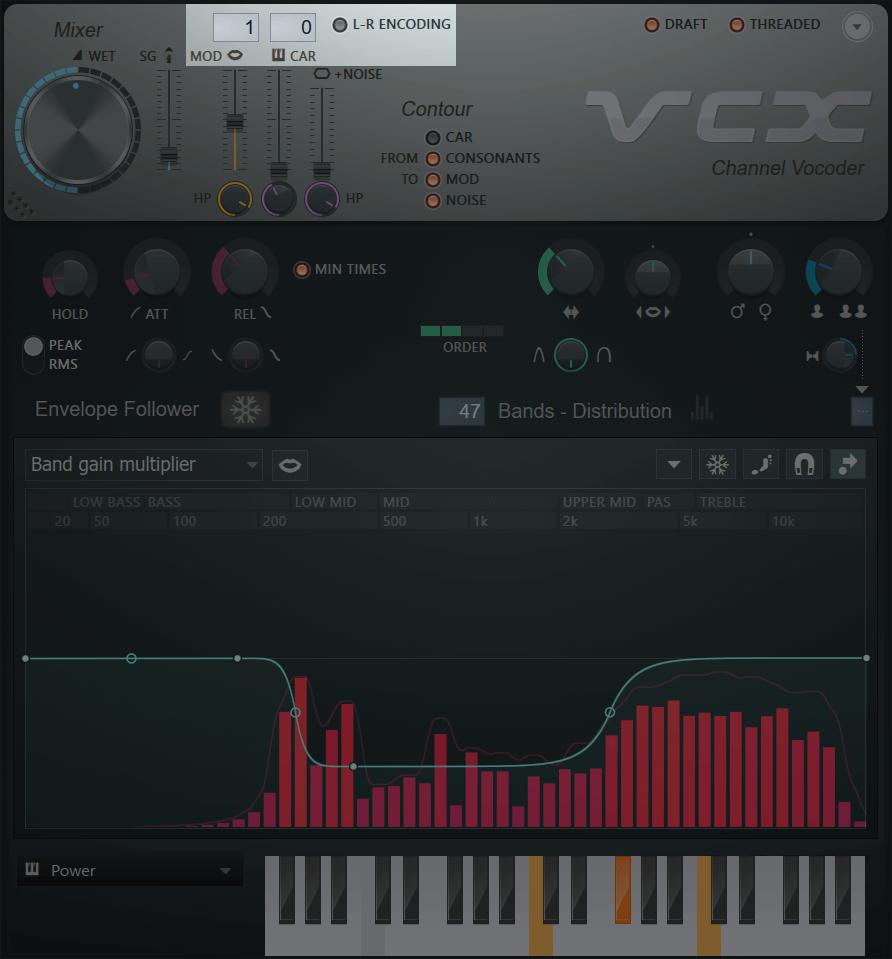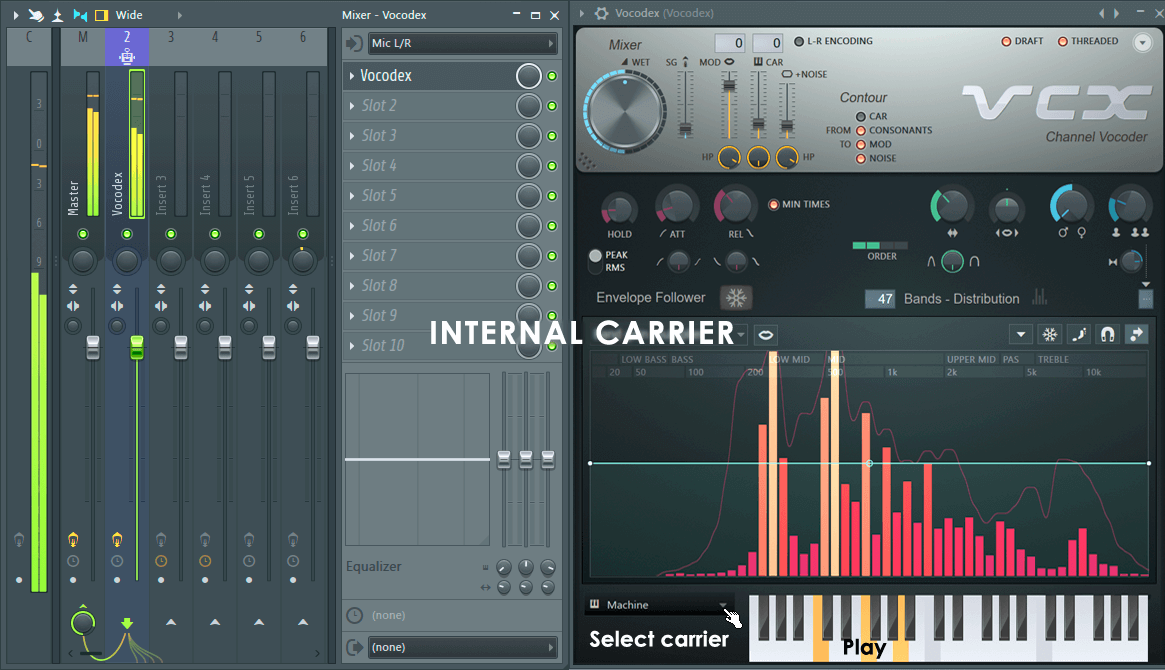MIXING & EFFECTS
Vocodex 
Vocodex is the last word in vocoders, featuring advanced articulation envelopes, integrated Carrier synthesizer and Soundgoodizer maximizer, vocoder envelope control and up to 100 variable-width multi-parameter vocoder bands. Vocodex - By your command!
Related plugin - Fruity Vocoder.

Vocoding is the process of using the real-time frequency spectrum of one sound (Modulator) to modulate the frequency spectrum of another (Carrier). The vocoder engine consists of a series of bandpass filters that allow through only those frequencies detected in the Modulator source. So, for example, when a human voice is used to modulate a synthesizer chord, it will sound like the synthesizer is talking, the classic robot voice from many sci-fi movies.
Setup Inputs
A vocoder needs two audio sources to work:
- A Carrier - The sound that donates its timbre & pitch. This is the sound you hear (usually a synthesizer). Stereo carriers pass through Vocodex in stereo, mono carriers will remain mono so a lush stereo carrier will often sound better. NOTE: The internal Carrier synthesizer is provided for live 'demo' purposes, use the external Carrier 'Production Method' (described below) for project work.
- A Modulator - The sound that will control the frequency spectrum of the Carrier, usually the spoken voice. The Modulator is not usually heard directly. NOTE: Modulator band analysis is peformed on the mono sum of the L + R channels, although modulator pass-through is stereo.
Vocodex is very flexible with respect to Modulator and Carrier input routing, via the MOD and CAR input selectors. Vocodex inputs work with the Mixer sidechain routing system. In this way, audio from any other pair of Mixer tracks can be routed directly to Vocodex's MOD and CAR inputs once these are sidechained to Vocodex's Mixer track. NOTE: If a MOD or CAR input is set to '0' then the audio passing through Vocodex's own Mixer track will be used on that input. If the selector is set to '---' then external Mixer track inputs are blocked.
Immediate Method - External Modulator with Internal Carrier
The 'Immediate' method relies on the internal Carrier (synthesizer) generator built into Vocodex and is intended for live demo use, where you don't need to control the Carrier synthesizer from the Piano roll (see the note at the end of this method), the setup is as follows:

- Load - Vocodex in a Mixer track (don't use the Master track).
- MOD input - Route the Modulation source to the same track as Vocodex OR if you plan to use a live mic, then select your microphone as an INPUT on Vocodex's Mixer track.
- Select an immediate preset - Select one of the 'Immediate' category of presets, these all use the internal Carrier synthesizer. Notice the CAR input changes to '---', this disables external Carrier input. The MOD input will show '0' offset indicating Vocodex's own Mixer track.
- CAR input - Use the Carrier Synthesizer menu to select a Carrier sound. On selection of a preset you should hear the word 'Vocodex' expressed according to the Carrier sound. See the Carrier Synthesizer section below for more details.
- Keyboard - If Vocodex is focused it will respond to your MIDI controller. When using a MIDI controller the keyboard will hold keys/chords until the next note/chord is played. Alternatively you can use your mouse on the Vocodex piano keyboard to latch keys on/off.
- Operation - Make sure Vocodex is focused (click on Vocodex to focus it) then play the project or speak into your microphone while manipulating the keyboard (mouse or MIDI controller), and you should sound like a Cylon, Daft Punk or just plain annoying to family members.
NOTE: The internal Carrier mode is aimed at live use since Vocodex does not respond to Piano roll notes. There is no path from the Piano roll or Step Sequencer to Effects plugins. See the Carrier Synthesizer section below for more details on how to replicate the internal Carrier sounds with Sytrus.
Production Method - External Modulator & Carrier
The 'Production' method allows an external plugin to provide the Carrier sound under the control of the Piano roll / Step Sequencer or MIDI keyboard. This method is intended for serious music production and vocoding duties. Vocodex can receive Modulator and Carrier signals from any of the other Mixer tracks (via sidechain sends) or from sound passing through Vocodex's own track (set the selector to 0). The default input selector setting assumes the Modulator comes from a Mixer track sidechained to Vocodex's track and the Carrier is routed to Vocodex's Mixer track:

- Load - Vocodex in a Mixer track effect slot (don't use the Master if you are planning to add other instruments to the project).
- MOD Mixer track - Identify and label a Mixer track as 'MOD'. Use a track other than Vocodex's Mixer track. The MOD Mixer track will contain the Modulation signal (usually speech, vocals, a live microphone input).
- MOD input - With the Modulation source Mixer track selected, Right-click on the Vocodex mixer track send switch and select Sidechain to this track only, to deselect the send to master switch and prevent the Modulator audio passing to the Master track.
- CAR input - Route the Carrier signal to Vocodex's Mixer track. The Channel Settings FX selector, of the plugin providing the Carrier sound, should match Vocodex's Mixer track number.
- Carrier sound - The most effective Carriers (the sound you hear) are those covering the whole frequency range. Thick lush synth sounds often make good Carriers. Try mixing in some noise from the NOISE slider if you need to hear speech (s & t sounds) vocoded more clearly. Remember, the vocoder acts like a series of gates allowing through those frequencies it detects in the Modulator sound. If a frequency band gate opens, and there are no frequencies in the Carrier over the same band, that 'tonal' character in the Modulator will be lost as it does not exist in the Carrier sound. NOTE: See the Carrier Synthesizer section below for more details on how to locate Sytrus presets designed specifically for Carrier duties.
- Modulator sound - In the case of speech, some compression usually helps with intelligibility of the vocoded sound as it brings up the level of the quieter parts, improving the frequency-band detection process.
NOTE: You can of course, use the MOD and CAR selectors to choose a Modulator and Carrier signal from any number of Mixer tracks sidechained to Vocodex's Mixer track. Giving the source Mixer tracks clear MOD and CAR labels will help you to select the right ones.
Parameters
Carrier Synthesizer
Vocoding Tutorials
Plugin Credits: Didier Dambrin
Vocodex sample: Katy Theodossiou.